Computation of ratios | Accountancy - Turnover ratios | 12th Accountancy : Chapter 9 : Ratio Analysis
Chapter: 12th Accountancy : Chapter 9 : Ratio Analysis
Turnover ratios
Turnover ratios
Turnover ratios show how
efficiently assets or other items have been used to generate revenue from
operations. They are also called as activity ratios or efficiency ratios. They
show the speed of movement of various items. They are expressed as number of
times in relation to the item compared.
The important turnover
ratios are:
i.
Inventory turnover ratio
ii.
Trade receivables turnover ratio
iii.
Trade payables turnover ratio
iv.
Fixed assets turnover ratio
(i) Inventory turnover ratio
It indicates the number
of times inventory is turned over to make revenue from operations (sales)
during a particular accounting period. It is a comparison of cost of revenue
from operations (cost of goods sold) with average amount of inventory during a
given period. It is calculated as under:
Inventory turnover ratio
= Cost of revenue from operations / Average inventory

Cost of revenue from
operations = Purchases of stock in
trade + Changes in inventories of finished goods + Direct expenses
(or)
= Revenue from
operations – Gross profit
Tutorial note
Revenue from operations
is the net sales.
Changes in inventory =
Opening inventory – Closing inventory
Direct expenses = Wages
+ Carriage inwards + Freight inwards + Dock charges + Octroi + Import duty +
Coal, gas, fuel and power + Other direct expenses
Average inventory = [
Opening inventory + Closing inventory ] / 2

Cost of revenue from
operations is taken because the inventory is always valued at cost except when
net realisable value is lower than cost, it is valued at net realisable value.
Greater the inventory turnover ratio, greater is the efficiency in the movement
of stock. However, high inventory turnover ratio may also be due to
insufficient inventory, buying in small quantities, etc. Similarly, a low
inventory turnover ratio may be due to inclusion of obsolete items in
inventory, etc. Hence, inventory turnover ratio must be analysed together with
the related items.
Tutorial note
In the absence of
opening inventory, closing inventory can be taken instead of average inventory.
Inventory conversion period
Inventory conversion
period is the time taken to sell the inventory. A shorter inventory conversion
period indicates more efficiency in the management of inventory. It is computed
as follows:

Inventory conversion period (in days) = Number of days in a year /
Inventory turnover ratio
Inventory conversion period (in months) = Number of months in a year / Inventory turnover ratio
Illustration 8
From the given
information calculate the inventory turnover ratio and inventory conversion
period (in months) of Sania Ltd.
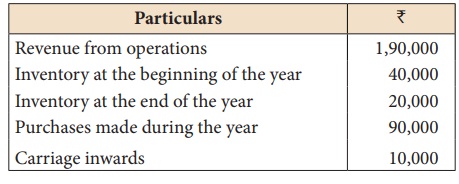
Solution

Cost of revenue from operations
= Opening inventory + Net Purchases + Direct expenses (carriage inwards) – Closing inventory
= 40,000 + 90,000 + 10,000 – 20,000
= ₹ 1,20,000
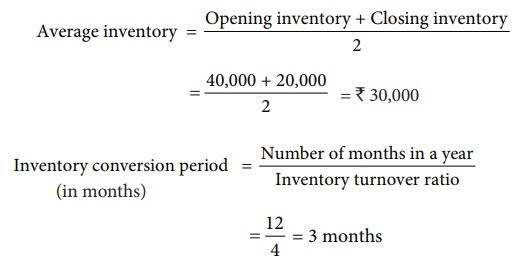
(ii) Trade receivables turnover ratio
Trade receivables
turnover ratio is the comparison of credit revenue from operations with average
trade receivables during an accounting period. It gives the velocity of collection
of cash from trade receivables. It is calculated as follows:

Trade receivables
turnover ratio = Credit revenue from operations / Average trade receivables
Average trade
receivables = [ Opening trade receivables + Closing trade receivables ] / 2
Trade receivables = Trade debtors + Bills receivable
Credit revenue from
operations (net credit sales) is taken for trade receivables turnover ratio as
trade receivables arise only from credit sales. Greater the trade receivables
turnover ratio, greater is the efficiency of management in collection of
receivables.
Tutorial note
In the absence of
opening trade receivables, closing trade receivables can be taken instead of
average trade receivables to calculate the ratio.
Debt collection period
Debt collection period
is the average time taken to collect the amount due from trade receivables.
Lesser the debt collection period, greater is the efficiency of management in
collection of cash from trade receivables. It is calculated as follows:
Debt collection
period (in days) = Number of days in a
year / Trade receivables turnover ratio
Debt collection
period (in months) = Number of months in
a year / Trade receivables turnover ratio

Illustration 9
The credit revenue from
operations of Harini Ltd. amounted to ₹
9,60,000. Its debtors and bills receivable at the end of the accounting period
amounted to ₹ 1,00,000 and ₹ 60,000 respectively.
Calculate trade receivable turnover ratio and also collection period in months
Solution
Trade receivables
turnover ratio = Credit revenue from operations / Average trade receivables
= 9,60,000 / 1,60,000 =
6 times.

Trade receivables = Debtors + Bills receivable = 1,00,000 + 60,000 = ₹ 1,60,000
Tutorial note
Closing trade receivables
are taken instead of average trade receivables as the opening trade receivables
are not given.
Debt collection period
= Number of months in a year / Trade receivables turnover ratio
= 12/6 = 2 months

(iii) Trade payables turnover ratio
Trade payables turnover
ratio is the comparison of net credit purchases with average trade paybles
during an accounting period. It gives the velocity of payment of cash towards
trade payables. It is calculated as follows:
Trade payables
turnover ratio = Net credit purchases / Average trade payables
Net credit purchases =
Total credit purchases – Purchases returns
Average trade payables
= [ Opening trade payables + Closing trade payables ] / 2
Trade payables = Trade
creditors + Bills payable

Greater the trade
payable turnover ratio, better is the efficiency of the management in managing
trade payable as it indicates that amount due to suppliers are settled quicker.
Tutorial note
In the absence of
opening trade payables, closing trade payables can be taken instead of average
trade payables.
Credit payment period
It is the average time
taken by the business for payment of accounts payable. Lesser the credit
payment period, greater is the efficiency of the management in managing
accounts payable as it indicates quicker settlement of trade payables. It is
calculated as follows:
Credit payment
period (in days) = Number of days in a
year / Trade payables turnover ratio
Credit payment
period (in months) = Number of months in
a year / Trade payables turnover ratio

Illustration 10
From the following
figures obtained from Kalpana Ltd, calculate the trade payables turnover ratio
and credit payment period (in days).

Solution
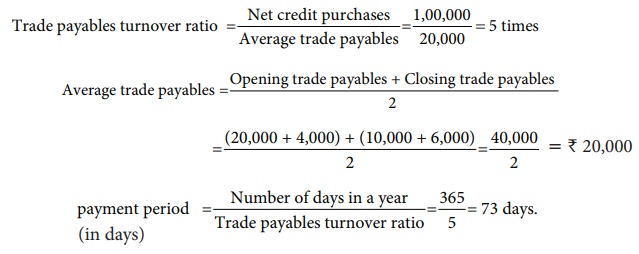
(iv) Fixed assets turnover ratio
Fixed assets turnover
ratio gives the number of times the fixed assets are turned over during the
year in relation to the revenue from operations. This ratio indicates the
efficiency of utilisation of fixed assets.

Fixed assets turnover
ratio = Revenue from operations /
Average Fixed assets
Average fixed assets =
[ Opening fixed assets + Closing fixed assets ] / 2
Greater the fixed assets turnover
ratio better is the efficiency of management in utilisation of fixed assets.
Tutorial note
In the absence of
opening fixed assets, closing fixed assets can be taken instead of average
fixed assets.
Illustration 11
From the following
information of Ashika Ltd., calculate fixed assets turnover ratio:
i.
Revenue from operations during the year were ₹ 60,00,000.
ii.
Fixed assets at the end of the year was ₹ 6,00,000.
Solution
Fixed assets turnover
ratio = Revenue from operations / Average Fixed assets = 60,00,000 /6,00,000 =
10 times

Tutorial note
As opening fixed assets
are not given, fixed assets at the end are taken instead of average fixed
assets.
Illustration 12
Calculate (i) Inventory
turnover ratio (ii) Trade receivable turnover ratio (iii) Trade payable
turnover ratio and (iv) Fixed assets turnover ratio from the following
information obtained from Delphi Ltd.

Additional information:
(i) Revenue from operations for the year ₹ 10,50,000
(ii) Purchases for the year ₹ 4,50,000
(iii) Cost of revenue
from operations ₹
6,00,000.
Assume that sales and
purchases are for credit.
Solution
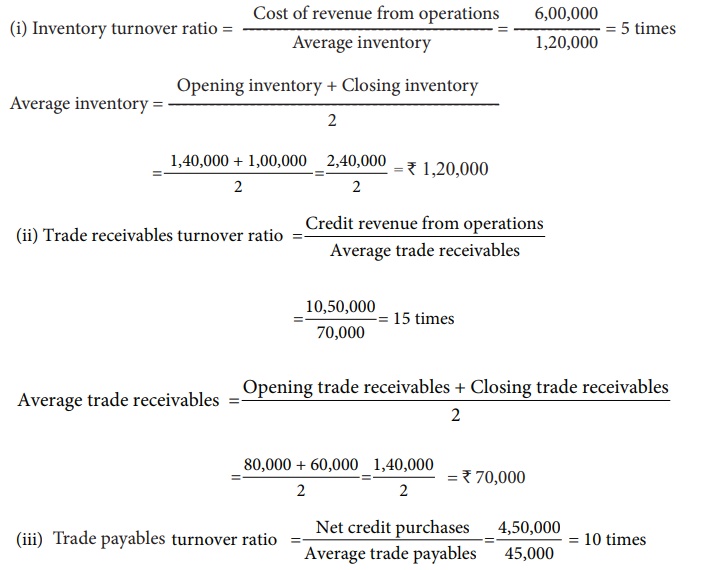
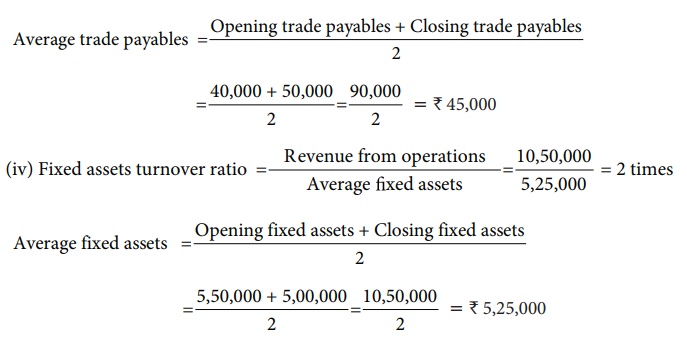
Related Topics